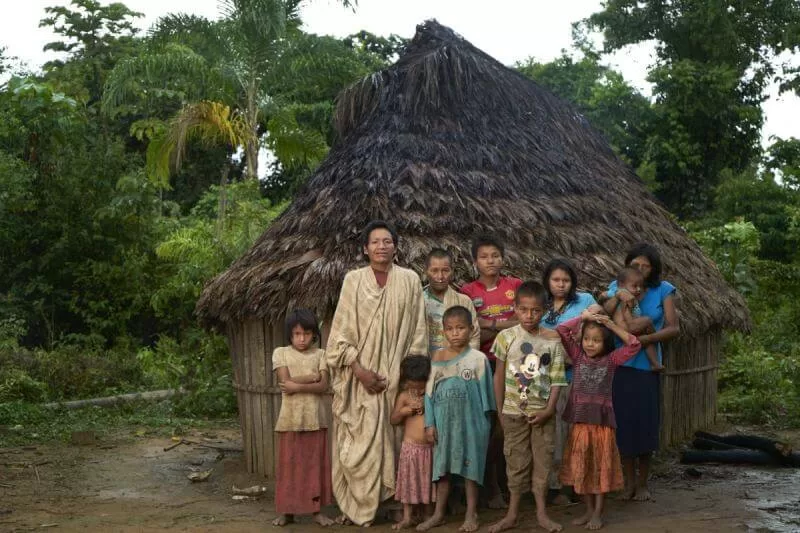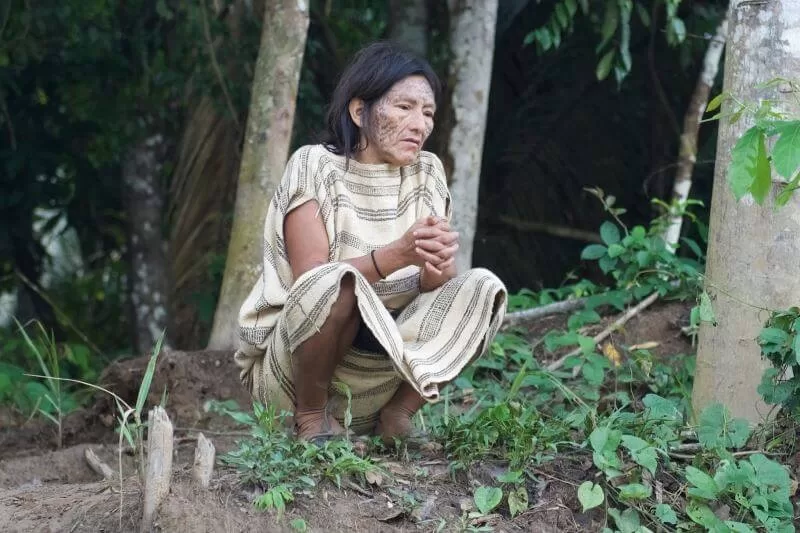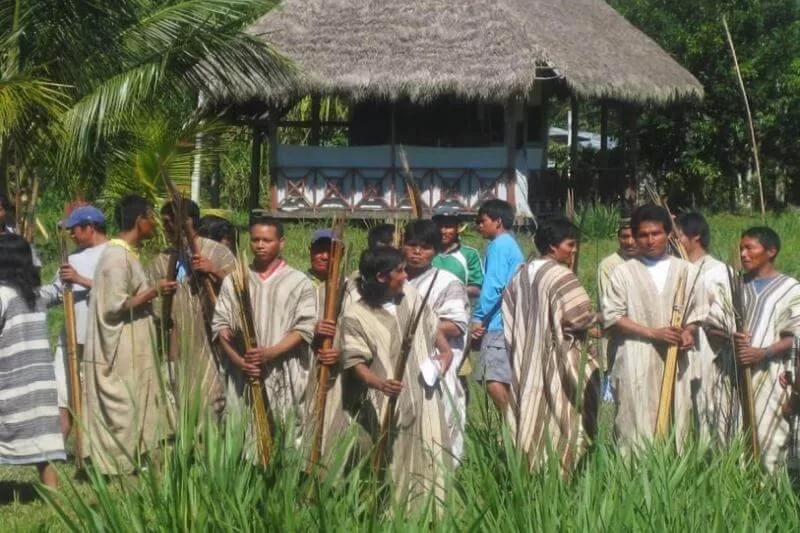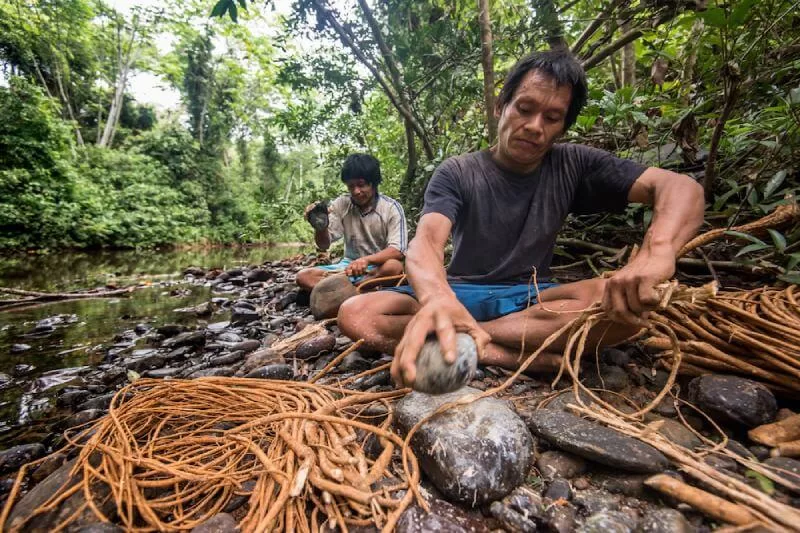The Manu is part of the land of the Matsiguenga. Deep within the National Park these peoples thrived for hundreds of years. This region offers a gateway to understanding the unique culture of the Matsiguenga people. Because Manu’s treasure goes beyond biodiversity.
Our adventure will take us through the Amazon rainforest, where the Matsiguenga have lived for centuries. With each step, we’ll uncover the secrets of their sustainable practices and their connection to nature. This experience promises an authentic glimpse into a way of life that prioritizes harmony with the environment.
By the end of our journey, you will see why Manu is not just a destination but a profound cultural immersion. The Matsiguenga’s vibrant community and rich heritage offer lessons in resilience and sustainability. So pack your bags, and let’s discover the indigenous guardians. Join us in this adventure.
Deep in the Amazon rainforest, the Matsiguenga people have lived harmoniously with nature for centuries. They inhabit the expansive and biologically diverse Manu National Park, often referred to as the land of the Matsiguenga. This indigenous community is part of the rich cultural tapestry of South America, particularly Peru.
The Matsiguenga call the remote stretches of the Peruvian Amazon home. The community lives along the rivers that snake through Cusco and the Madre de Dios region.
These waterways are lifelines, supporting their traditional lifestyle that relates to the environment. The Matsiguenga have their deep spiritual connection to the land. This influences both their beliefs and their daily practices.
Spirituality plays a central role in their culture, with a strong belief in the spiritual presence in natural elements. They regard the forests, rivers, and wildlife around them as sacred entities. Such reverence ensures the practice of sustainable hunting and fishing.

The Matsiguenga are skilled hunters and gatherers, which is essential for their sustenance. They use bows, arrows, and spears, crafted from materials sourced directly from the cloud forests surrounding them. These tools hold cultural significance, often decorated with symbols that represent their spiritual beliefs.
Agriculture also forms a part of their sustenance, with manioc (cassava) being a staple in their diet. They cultivate it using slash-and-burn techniques, which, when controlled, help maintain the health of the soil. This method shows their understanding of cyclic regeneration, a principle deeply embedded in their way of life.
Weaving is another crucial aspect of Matsiguenga culture. They traditionally create garments from natural fibers.This get their colors using plants and minerals found within their environment. These garments often tell stories. The textile decor the people during various ceremonies and rituals.
In modern times, the Matsiguenga have become advocates for environmental conservation. They work closely with local and international bodies to protect Manu National Park, a UNESCO Biosphere Reserve. The region’s unique flora and fauna, including the iconic Cock of the Rock, needs protection..
Tourism has also become a part of life for the Matsiguenga, though they approach it cautiously. By inviting tourists to experience the land of the Matsiguenga, they educate outsiders. These interactions provide a sustainable income source while fostering greater respect and understanding among visitors from around the globe.
The role of the Matsiguenga in maintaining the ecological balance of the Manu National Park is prevalent. Their lifestyle and beliefs continue to influence conservation strategies in the region. As stewards of the land, the Matsiguenga remind us of the importance of living in harmony.

The Matsiguenga, an indigenous people, thrive in South America’s Amazon rainforest. This resilient community found the land of the Matsiguenga on this natural wonder. Through their daily practices and spiritual beliefs, they maintain a unique harmony with nature. We should pay deep respect and preserve their traditional territory.
Family is the cornerstone of Matsiguenga society. They live in small, scattered settlements, which foster close-knit relationships and communal support. Each family unit collaboratively works the land, hunts, and gathers, ensuring mutual survival and well-being. Their homes, constructed from materials sourced directly from the rainforest, blend seamlessly into the environment.
Respect for the natural world is deeply ingrained in their belief system. The Matsiguenga see the spirits of their ancestors in the rainforest, guiding and watching over them. This profound connection dictates their ecological practices, encouraging sustainable interactions with the environment. They believe that the health of their land directly impacts their community’s health.
The Matsiguenga’s relationship with their environment is a model of sustainability. They practice shifting cultivation, which prevents soil depletion and preserves forest cover. This method involves clearing a small area of forest for cultivation, then allowing it to regenerate over several years. They grow crops like plantains, yuca, and sweet potatoes, which are staples of their diet.
Hunting and fishing happen with a great respect for the animal spirits. The Matsiguenga use traditional methods that ensure species can repopulate. This balance keeps the ecosystem intact and supports biodiversity in the land of the Matsiguenga. Even their fishing techniques are non-invasive, using handcrafted tools that minimize environmental impact.
Spirituality is ever-present, influencing every aspect of life. They hold rituals to thank the spirits for harvests and hunts, ensuring continued abundance and protection. These rituals strengthen community bonds and reaffirm their commitment to the spiritual and physical health of their environment.

The land of the Matsiguenga is more than a home; it is a legacy of living in tune with nature. As modern pressures threaten to encroach on their territory, recognizing and respecting their land rights is crucial. They have proven themselves as effective stewards of one of the most biodiverse areas on Earth.
Efforts to protect their territory support Matsiguenga cultural preservation. At the same time it contributes to global environmental goals. Their traditional knowledge offers valuable insights into sustainable living.
The Matsiguenga teach us the importance of respecting indigenous rights and knowledge. As they fight to maintain their way of life, they also protect the Manu. Supporting their sovereignty over the land of the Matsiguenga preserves the cultural diversity of.
In the land of the Matsiguenga there is a harmonious relationship between indigenous communities and nature. The Matsiguenga, along with other native groups, play a pivotal role in the conservation efforts. Their traditional knowledge and sustainable practices are integral to preserving the ecological balance.
The Matsiguenga have historically lived in ways that minimize their impact on the environment. Their methods of hunting, fishing, and agriculture respect the natural cycles of the forest. They ensure that wildlife populations and habitats remain undisturbed. This deep-rooted respect for nature positions them as natural conservationists, vital to Manu’s ongoing health.
By maintaining their traditional lifestyle, the Matsiguenga help keep the ecological integrity of the broader ecosystems within Manu. Their presence and active management create a buffer against illegal activities.
Tourism in the land of the Matsiguenga offers a unique opportunity for cultural exchange and environmental education. Visitors to Manu National Park gain insight into the sustainable practices of its indigenous residents. This interaction fosters a greater appreciation and respect for the environmental and cultural values that the Matsiguenga uphold.
The Matsiguenga participate in ecotourism initiatives that promote a sustainable approach to visiting the Amazon.
They guide tours, share their knowledge of medicinal plants, and demonstrate their cultural practices. Providing an authentic experience helps preserve their traditional ways of life. This generates income for the local communities. Also educates visitors about the importance of conservation.
These tourism activities occur with the utmost respect for the land and its inhabitants. Minimizing the impact on the environment is an objective. The income generated supports the community and funds local conservation projects. Tourism is a vital part of the conservation strategy in the land of the Matsiguenga.
The conservation efforts of the Matsiguenga contribute to broader environmental objectives. Their traditional ecological knowledge is a valuable resource in managing the park.
Collaboration between the Matsiguenga and conservation organizations helps to align modern conservation techniques with indigenous practices. This partnership ensures that the strategies implemented are culturally sensitive and environmentally effective. It highlights the critical role of indigenous peoples in global conservation efforts. The need to support and respect their rights and knowledge should be a priority.
The importance of the Matsiguenga in the functioning of Manu National Park is central. They are guardians of their ancestral land. Their role in conservation is an excellent example of how indigenous practices can contribute to global environmental goals.

If you got any questions, please do not hesitate to send us a message. We reply within 24 hours!
+51 900 394 399
info@biomanuexpeditions.com
reservas@biomanuexpeditions.com
